
MONDAY, JAN 31, 2011

Understand the Exponential Function
Growth is the best thing imaginable, for a time
"The greatest shortcoming of the human race is our inability to understand the exponential function." —Albert Bartlett
Eric Lee, A-SOCIATED PRESS
TOPICS: EXPONENTIAL FUNCTION, GROWTH, FULL SPEED AHEAD, FROM THE WIRES, REALITY-BASED, SURVIVAL ISSUES
Abstract: Foundational to sustainability issues is understanding the implications of the exponential function which Anthropocene enthusiasts cannot understand since their enthusiasm would be forfeit, and likely their paychecks. Denial enables them to work to help keep the growth society keep on keeping on, for a time.
TUCSON (A-P) — A classic introduction to the exponential function
involves yeast added to a culture medium. So let's imagine a spherical
vat with a diameter of 86 feet (26.23 meters) containing 2,496,205
gallons (9,449,166 liters) of grape juice. A single yeast cell is added
(brewer's yeast average 3.5 microns, so if a yeast were the size of a
human [1.7 m], the vat would be the size of Earth). Yeast can grow and
divide every hour, so at the end of the first hour there are two yeast.
At the end of the second, there are four yeast. At the end of the third
hour there are eight, then 16, 32, 64, and so on.
Growth continues, hour after hour, with each hour, from the yeast's
point of view, resembling the last—each generation ends up with twice as
many neighbors. As the alcohol (yeast excreta) level in the vat slowly increases, other
organisms living in the vat begin to die off. Things just keep getting
better and better for the yeast until only yeast remains alive.
Everything continues to go along swimmingly until the 43rd hour when the
yeast population reaches 4.4 trillion, and the vat is "full" of yeast.
The level of alcohol has finally become so toxic that even the yeast
can't survive, and by the end of the 43rd hour all the yeast are dead
(or cease to function). But yeast is adapted. They sporulate before
they die and yeast spores are everywhere--waiting for an opportunity to
grow exponentially again, as it is their nature to do so. Other species
are not as adapted to overshoot and collapse.
Now the question, dear student, your final exam so to speak, is this: In what hour was the vat half full?
 The answer, as Deep Thought has already computed, is 42.
The answer, as Deep Thought has already computed, is 42.
So what? Ah, well, look around you. You might be doing just fine, but
how many of your fellow 7+ billion humans can say the same (3.5 billion people live in households that live on less than $10/day)? Given the
increasing difficulties of providing, however inadequately, for the
current 7 billion people, do you think Earth can support 14 billion
people? If you do, then you believe we are living at the start of the
42nd hour.But the fertility rate is dropping, the population will only get to 11 billion around 2100, so none of this exponential stuff matters. But if the population does NOT continue to increase, the rate of GDP growth can't continue, so incentives will....
Maybe you're wildly optimistic and think that ever new and clever
solutions will be forthcoming so that surely 28 billion people is not
too many to be provided for. If so, then you believe we're living at the
beginning of the 41st hour. Well, bad news for those who would like to
believe so; the consensus among those who think about these things
(scientists) is that the 41st hour has come and gone, that the planet is more than 1/4 full of humans and their plant/animal mutualists. While our world is
vastly more complex than that of yeast in a culture tube, some truths
don't go away by obfuscation. That the population will never reach 14
billion, due to the alleged demographic transition that is due to peak at about
11 billion around 2100, is likely.
So nothing to worry about, right? The planet could support 28
billion or surely 14 billion is supportable, and the population will peak at just 11 billion. It's all good. The
11 billion will share what the 28 billion would have had. The real
problem in the future may be depopulation post-peak. People will have to
be paid to have children. If population growth can't be maintained,
everyone will have to consume evermore to sustain economic growth. Who's
going to complain about having to consume more? Naysaying ecofacists?
Growth, any rate of growth (economic or populations of humans, pets, livestock, crops) however small, in a finite system (e.g. Earth or the Milky Way), cannot continue—period;
no ifs, ands, or buts about it. You can take it to the bank, stick it
in your pipe, whatever you want to do, but this fact (not an opinion or even a deeply held belief) doesn't go away.
Growth is not limited to population. Per capita growth in consumption is also limited. While our population may max out at 11 billion, all will want enough and most are being oversold on wanting more, far more than they need. Consumptive growth is limited. Self-delusion works for a time, but in the end reality will creep in. With unlimited energy "too cheap to meter" we might be able to pave over the entire land surface, cover the oceans in floating cities, tunnel out the lithosphere, grow food in well-lit caves, but at some point (a near future) growth would still have to come to an end.
When people had to have six or eight kids so that maybe two might
survive childhood, when child mortality drops to such an extent that
most survive, then most people don't want to have eight kids. With birth
control technology readily available, population growth rate declines,
the "demographic transition" happens as it is happening. If there really
were too few humans on the planet, people might have to be rewarded one
way or another for having more than two children. The issue is not
continued exponential population growth
with no end in sight, but continued expectations of ever increasing
"progress" towards having more as in consuming more stuff. Currently, the
world's poor are getting slightly better off materially while the rich
get disproportionately richer. When per capita consumption peaks and
people, the commoners, see themselves getting poorer, expectations will change and the
social order that serves elites will collapse as it always has. Someone
will start a rumor that the First Lady said, "Let them eat cake,"
and.....
We're not talking about just population growth, but any material
growth. Even if the human population leveled off around 2050 at 9
billion, the demand for growth in per capita consumption would not stop.
China's consumption (economy) has been growing at 10% a year at which
rate it will double every seven years (only 7% in 2015 so
doubling down to every 10 years). How long can that be sustained and at
what cost? Current economic systems begin to falter if the rate of
growth declines—not growth itself, but merely if the rate of growth declines. Any growth less than 3%, with a per capita doubling time of less than 25 years, is called a recession.
You are living in a growth culture powered largely by
fossil fuels during a meteoric rise. The Growth Culture knows nothing
else; it can't even imagine a world without growth ("In Growth we trust"). So far, each century
has resembled the last, things seemingly just keep
getting better and better (not for nature but for us and our domestic
plants and animals at least). But it won't last; it absolutely can't continue to get better and better.
The 43rd hour will be unlike all the previous ones. Understanding this is crucial. Nothing we've ever known so far will prepare us for it (though reading history helps). We are not yeast in a vat, we are just behaving like them. Few are predicting total die-off, but an 80% die-off in the 21th century is not unthinkable (James Lovelock: Enjoy life while you can)."The Sunday morning talk shows are host to a variety of pundits debating the week's hottest policy issues. But on one issue it appears that a consensus has been reached: Whether the economy is backtracking or headed full-steam ahead, the belief that economic growth can be sustained in perpetuity trumps all. Sunday morning is for many a time of worship and reflection [on unquestined certitudes], but every day a national coalition of media, politicians, and business leaders kneel at the altar of economic growth. It is the creed [unquestioned certitude] to which we subscribe, the mantra we subconsciously chant." [that thereby self-selects of] —Anne Manetas, book review of Shoveling Fuel for a Runaway Train by wildlife biologist Brian Czech. published in The Social Contract (Summer 2001): Issue theme: "'The Limits to Growth' - honoring the memory of Donella Meadows"
You are living in the 42nd hour. It's just a question of whether we are in the early or late part of the hour. Is the world only half full? Do we have 50 minutes remaining? Maybe 20 minutes (years)? Or are we towards the end with only five minutes remaining? Actually the exact "moment" of Peak Everything (climax) won't be known until after the fact, so perhaps we are already into the 43rd hour.
/
If yeast were as smart as humans, would they foresee the 43rd hour and
avoid it? No, because they have evolved to cope by sporulation. If they
were like humans, they would likely believe, during the growth period,
that their Creator had obviously given them dominion over the vat,
favored them above all creatures, and blessed them exceedingly in their
unending growth. For 42 hours there would be no evidence to discount
this view.
How many humans can even imagine the possibility that they might be
wrong? How many, even well into the 43rd hour, will still be in denial?
Maybe by 2050 fusion power plants will have sprung up everywhere and
the upward trend will continue through the 21st century. Or space will
be filled with solar arrays surrounding the sun beaming energy to Earth. Maybe a Dyson sphere will be constructed.
Yes, absolutely maybe, but don't count on it or assume continued growth is a good thing, most devoutly to be hoped for. Even if
growth continues through the 22nd century, its continuance will change
nothing; it will merely make the industrial growth culture bigger and
fall harder. Even if all solar energy emanating from the sun were
intercepted (a Dyson sphere), it wouldn't be enough to sustain growth.
Humans would at least have to stop growth while they emigrated to other
solar systems to consume them and any life they may find would be
assimilated too.
If you're beginning to think that the exponential function is something you really need to understand, here's Professor Bartlett's masterful presentation that he gave for over three decades, 1,742 times from 1969 until he died in 2013, subtitled "Sustainability 101." Don't use the word "sustainability" unless his message has become etched on your neural net. When he was exploring the implications of this function, he had one of the first electronic pocket calculators. He was calculating how long known coal reserves would last assuming a certain rate of consumption. He kept getting an absurdly small number and became convinced the calculator was malfunctioning. He broke out his log rhythm tables and got the same answer. The point is that while the exponential function is not hard to understand—it's simple arithmetic; it is hard to accept—to see the implications. But give it a chance to sink in. It could be that nothing you do could be more important than understanding the ramifications.
And read the transcript to better allow his message to sink in.
To bring home the implications, consider the following graphs:
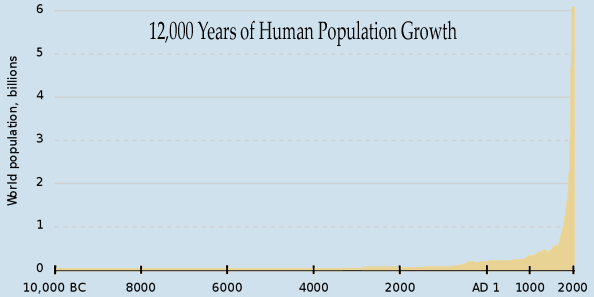
This graph should keep you awake at night. If it doesn't, you haven't been paying attention. It shows only the rise of human population. The following graph shows the rise and fall of
yeast in the vat. The fall during the 43rd hour happens so quickly that
it is barely noticeable on the graph. We'll soon know whether humans
are smarter than yeast.

In 1944, 29 reindeer were introduced to St. Matthew Island. In 1957
there were 1,350 rather fat reindeer. In 1963 the population reached
about 6,000. In 1966 there were 42 survivors. An unusually severe winter happened, as usual. A 100-year freeze happens about every...., but the population was stressing island resources unsustainably, were stressed, so were perhaps not in peak shape for winter, and 42 survived, but that's a detail. They would have collapsed the system anyway. Let's say that in 1957 a scientist reindeer did a study and estimated the maximum sustainable population for the island, given the slow growth of lichen, was 42. It was important to maintain the population well under environmental resources so that when the 100-year winter came all the reindeer were fat and prepared and could find food even with heavy snowfall. In a predator-free environment, reproduction would have to be limited. She shared her concerns with all the other reindeer. She died, left a book, but none of the other reindeer read it, so.... By the 1980's, the last
reindeer on the island had died.
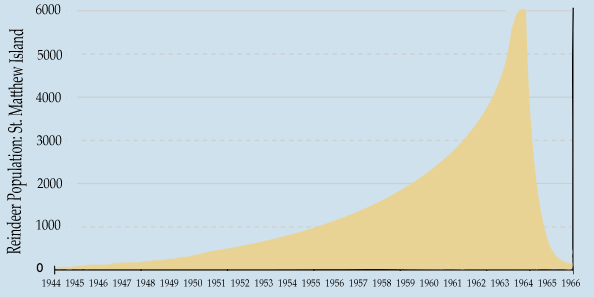
Here's another look at human population growth over the last 4,000 years.

The slight dip in the 14th century was the Black Death. The question
becomes, what will the 21th century look like? If you're like most
people, you expect it to look like this:

It currently looks like population will peak at 11 billion at most. But the future could look like this:
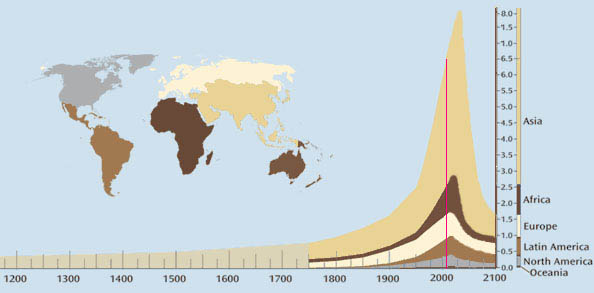
Other futures are possible, but probable futures are likely to fall between Future A and C. Descent is foreseeable. The exact point (to the year) of peak growth is not. From the point of view of geological time or even history, the difference between A and C is distinguishable only using a magnifying glass. What we are living in is a blip.
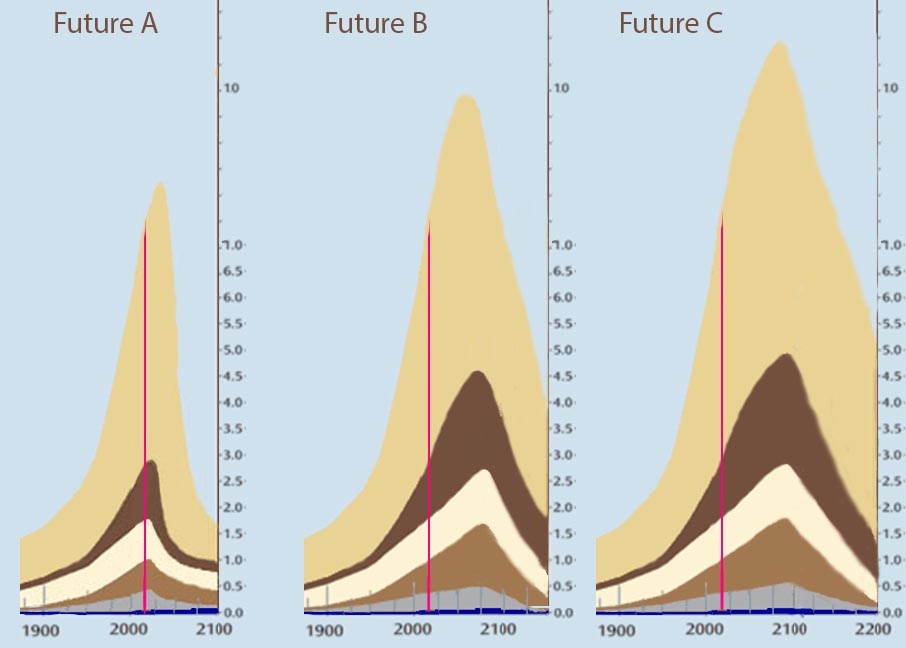
Population issues shouldn't be dismissed because the 'demographic transition is going to automatically solve the alleged problem of 'overpopulation'. In the last 60 years in China, for example, population grew 60%, while consumption per capita grew 300%, a five fold increase (growth). Even if China had stuck with its one child policy until the population actually stopped growing, there is no end in sight to growing per capita consumption in China or anywhere else. The impact (I) of industrial humans (e.g. mass extinction) is population (P) times per capita consumption of planetary resources (A) times the impact of the technology (T) used to support industrial society for a time. For 300,000 years our ancestors lived by foraging for resources. Since agriculture, we shifted from hunting-gathering to producing food by 'the sweat of our brows' along with technology. Since the Industrial Revolution we have gone back to being foragers, scouring the planet for resources (fossil fuels, metals, minerals) almost all which are non-renewable. Hunting and gathering was sustainable. Some forms of agriculture in some areas was sustainable. Industrial foraging (for fossil fuels, phosphorus, etc. to turn into food) is not, and 'normal' is defined by an utter inability to understand why.
Population ecologist John B. Calhoun famously created mouse/rat Utopias which provided unlimited food, water, and nest materials. The only limit was space—kind of like an island paradise (or planet) so isolated that, should you ever want to leave, there's no place else to go. Even if there was a Planet B, colonizing it or deep space would just delay the reckoning slightly.
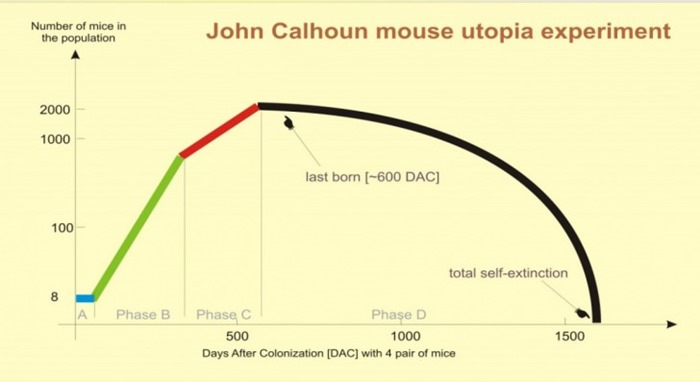 When four pairs of mice were given dominion over their Eden they
multiplied, fruitfully doubling their population every 55 days. By day
315 there were 620 mice at which point all normal social behavior
had broken down, the population declined as by day 600
there were no more surviving births—the remnant population continued to
decline, having completed their demographic transition, unto extinction in an environment where their every material
need was provided for.
When four pairs of mice were given dominion over their Eden they
multiplied, fruitfully doubling their population every 55 days. By day
315 there were 620 mice at which point all normal social behavior
had broken down, the population declined as by day 600
there were no more surviving births—the remnant population continued to
decline, having completed their demographic transition, unto extinction in an environment where their every material
need was provided for.
The reason for this curious outcome was that the social stressors of
too many mice increased the level of violence, conflict, and assorted
aberrant behaviors. This led to the breakdown of society and to a
failure to successfully parent such that those young who did survive
were themselves so dysfunctional, those who were not eaten, that they
could not successfully reproduce. The survivors avoided social
interaction and ended up dying alone.
The lesson here is that it is not enough to survive—you have to
survive with a functional culture intact, which excludes the growth
culture, if a functional society is to emerge on the other side of the
bottleneck. If only the most ruthless marauders or mindless ideologues
survive, no new civilization could develop from them for many, many
generations—if ever. It's not enough that just any culture survives; we
need to lay the foundations now of one that isn't going to just repeat
the same pattern and see to it that it survives. Calhoun became a compassionate revolutionary.
If the society you live in isn't going to change its course, perhaps
it's time you changed yours. Individuals can overcome the inertia of
large groups; only individuals, making intelligent choices using foresight, can
radically change course. The deer staring into the headlights often
fails to move or may even run in front of the truck. Endeavor to think well
now and decide upon a course of action before the headlights appear.
On a different scale:
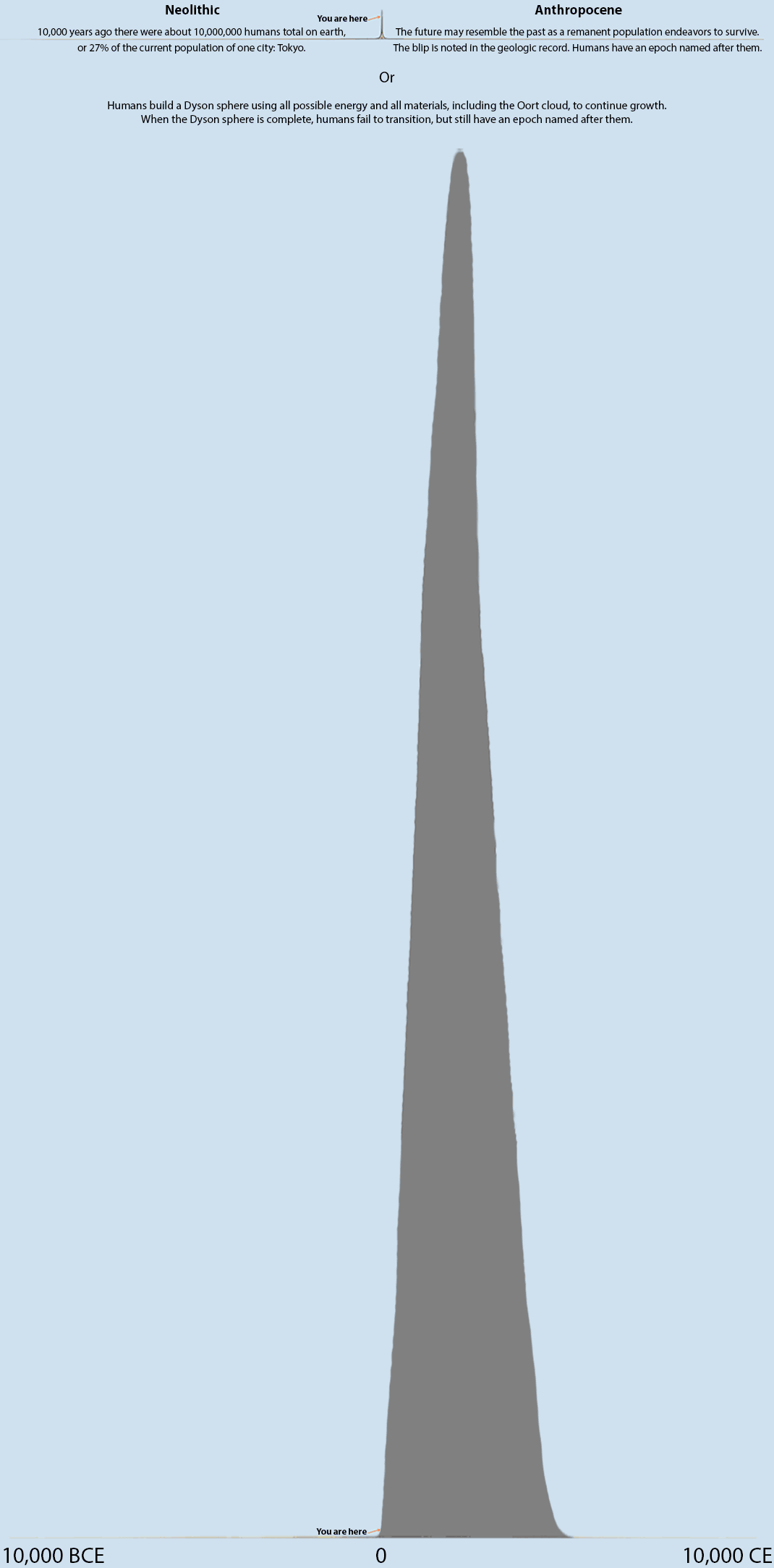
The first blip assumes human population maxes at 10 billion. The second maxes at about 30,000,000 trillion on a well designed Dyson sphere. If shown at the same vertical scale, the height of the peak would be about 3,000,000 trillion times higher, about 40,000 miles higher than shown. Humans may be smart enough to build a Dyson sphere, yet not smart enough to live sustainably on it. Assume the Dyson sphere contains trillions of civilizations, each with a population many times bigger than Earth's 21st century population. When complete, if any one of these civilizations continued to grow by consuming nearby civilizations (see last 6,000 years of human history), growing at their expense, just as a cancer cell grows at the expense of surrounding cells, then the resulting cancerous growth would have the same outcome. Be not a cancer on the earth or solar system. The ecolate life is alternative (e.g. Kogi).
Even if some humans go to other stars to build Dyson spheres, hundreds of billions of them, the blip would be the same, just on a different scale. In sixteen thousand years human growthers could blip out the Milky Way. Even if some go to other galaxies, and the entire visible universe blips out (all stars becoming infrared emitters), the growth culture would still be a blip in cosmic time. The end point would be the same. No growth as there would be no media/energy left to consume. Sustainable growth is impossible unless there are an infinite number of accessible and habitable multiverses. Transitioning now to negative growth in order to descend to a sustainable level of no growth is alternative.
 “You can plan all you want to. You can lie in your morning bed and fill whole notebooks with schemes and intentions. But within a single afternoon, within hours or minutes, everything you plan and everything you have fought to make yourself can be undone as a slug is undone when salt is poured on him [or a virus or technology fails...]. And right up to the moment when you find yourself dissolving into foam you can still believe you are doing fine.” So, understand the exponential function, bitches.
“You can plan all you want to. You can lie in your morning bed and fill whole notebooks with schemes and intentions. But within a single afternoon, within hours or minutes, everything you plan and everything you have fought to make yourself can be undone as a slug is undone when salt is poured on him [or a virus or technology fails...]. And right up to the moment when you find yourself dissolving into foam you can still believe you are doing fine.” So, understand the exponential function, bitches.
